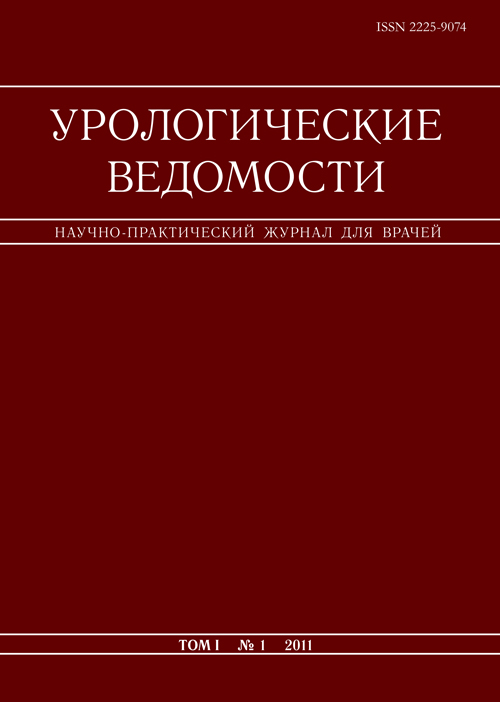Quality of life in patients with overactive bladder
- Authors: Al-Shukri S.K.1, Kuzmin I.V.1
-
Affiliations:
- Academician I.P. Pavlov First Saint Petersburg State Medical University of the Ministry of Healthcare of the Russian Federation
- Issue: Vol 1, No 1 (2011)
- Pages: 21-26
- Section: Original study articles
- Submitted: 07.01.2021
- Accepted: 07.01.2021
- Published: 07.01.2021
- URL: https://journals.eco-vector.com/uroved/article/view/57653
- DOI: https://doi.org/10.17816/uroved57653
- ID: 57653
Cite item
Abstract
The aim of study. To study an influence of overactive bladder on patients quality of life.
Patients and methods. An analysis of quality of life questionnaires (QQL) has been performed in 349 patients with overactive bladder and an impact of disease symptoms and urodynamic examinations results on individual components of patient’s quality of life has been studied.
Results. A significant reduction in quality of life in patients with overactive bladder takes place, which is manifested in worsening of all its components — social, family, emotional and professional. A level of reduction in quality of life depends on intensity of overactive bladder symptoms and differs depending on patient’s gender and age. More frequent urination and imperative feeling of urination had the greatest influence on quality of life indicators. A relation between the level of worsening of quality of life in patients and the results of urodynamic examinations hasn’t been defined.
Conclusion. A level of worsening of quality of life in patients with overactive bladder depends on intensity of symptoms, as well as patient’s gender and age.
Full Text
About the authors
Salman Kh. Al-Shukri
Academician I.P. Pavlov First Saint Petersburg State Medical University of the Ministry of Healthcare of the Russian Federation
Author for correspondence.
Email: alshukri@mail.ru
MD, PhD, Professor, Head of Department of Urology
Russian Federation, Saint PetersburgIgor V. Kuzmin
Academician I.P. Pavlov First Saint Petersburg State Medical University of the Ministry of Healthcare of the Russian Federation
Email: kuzminigor@mail.ru
ORCID iD: 0000-0002-7724-7832
https://www.ooorou.ru/ru/users/kuzminigor-mail-ru.html
Doctor of Medical Science, Professor, Urology Department
Russian Federation, Saint PetersburgReferences
- Abrams P., Kelleher C. J., Kerr L. A., Rogers R. G. Overactive bladder significantly affects quality of life // Am. J. Manag. Care. 2000. Vol. 6. P. 580–590.
- Abrams P., Cardozo L., Fall M. et al. The standardization of terminology in lower urinary tract function: report from the Standardization Sub-Committee of the International Continence Society // Urology. 2003. Vol. 61 (1). P. 37–49.
- Bushnell D. M., Martin M. L., Summers K. H. et al. Quality of life of women with urinary incontinence: cross-cultural performance of 15 language versions of the I-QOL // Qual. Life. Res. 2005. Vol. 14 (8). P. 1901–1913.
- Donovan J. L., Badia X., Corcos J. et al. Symptom and Quality of life assessment // Incontinence: 2nd International Consultation on Incontinence / Ed. Abrams P, Cardozo L, Khoury S, Wein A. Plymouth, 2002. P. 267–316.
- Jackson S. The patient with an overactive bladder — symptoms and quality of life issues // Urology. 1997. Vol. 57 (6A). P. 18–22.
- Kalsi V., Apostolidis A., Popat R. et al. Quality of life changes in patients with neurogenic versus idiopathic detrusor overactivity after intradetrusor injections of botulinum neurotoxin type A and correlations with lower urinary tract symptoms and urodynamic changes // Eur. Urol. 2006. Vol. 49 (3). P. 528–535.
- Kelleher C. J., Cardozo L. D., Khullar V., Salvatore S. A new questionnaire to assess the quality of life of urinary incontinent women // Br. J. Obstet. Gynaecol. 1997. Vol. 104 (9). P. 1374–1379.
- Kobelt G. Economic considerations and outcome measurement in urge incontinence // Urology. 1997. Vol. 50 (6A). P. 100–107.
- Kobelt G., Kirchberger I., Malone-Lee J. Quality-if-life aspects of the overactive bladder and the effect of treatment with tolterodine // BJU Int. 1999. Vol. 83 (6). P. 583–590.
- Milsom I., Abrams P., Cardozo L. et al. How widespread are the symptoms of an overactive bladder and how are they managed? A population-based prevalence study // BJU Int. 2001. Vol. 87 (9). P. 760–766.
- O’Connor R. M., Johannesson M., Hass S. L., Kobelt-Nguyen G. Urge incontinence: quality of life and patient’s valuation of symptom reduction // Pharmacoeconomics. 1998. Vol. 14. P. 531–539.
- Papanicolaou S., Hunskaar S., Lose G., Sykes D. Assessment of bothersomeness and impact on quality of life of urinary incontinence in women in France, Germany, Spain and the UK // BJU Int. 2005. Vol. 96 (6). P. 831–838.
- Rajkumar G. N., Small D. R., Mustafa A. W., Conn G. A. prospective study to evaluate the safety, tolerability, efficacy and durability of response of intravesical injection of botulinum toxin type A into detrusor muscle in patients with refractory idiopathic detrusor overactivity // BJU Int. 2005. Vol. 96 (6). P. 848–852.
- Samuelsson E., Victor A., Tibblin G. A population study of urinary incontinence and nocturia among women aged 20–59 years // Acta Obstet. Gynecol. Scand. 1997. Vol. 76. P. 74–80.
- Schafer W., Abrams P., Liao L. et al. Good urodynamic practices: uroflowmetry, filling cystometry, and pressure-flow studies // Neurourol. Urodyn. 2002. Vol. 21 (3). P. 261–274.
- Wein A. J., Rackley R. R. Overactive bladder: a better understanding of pathophysiology, diagnosis and management // J. Urol. 2006. Vol. 175 (3). P. 5–10.
- Wyman J. F., Fantl J. A., McClish D. K. et al. Quality of life following bladder training in older women with urinary incontinence // Int. Urogynecol. J. 1997. Vol. 8. P. 223–229.
Supplementary files










